 Thanks: 0
Thanks: 0
 Likes: 0
Likes: 0
 Needs Pictures: 0
Needs Pictures: 0
 Picture(s) thanks: 0
Picture(s) thanks: 0
Results 1 to 15 of 56
-
1st June 2009, 07:43 PM #1
 An 18th century style European Ash cricket table.
An 18th century style European Ash cricket table.
Mrs. Woodwould has increasingly remarked of late that she would like another small side table in our living room, so I undertook to produce one. I don't enjoy walking over the same ground and much prefer an eclectic style of furnishing a room, so I thumbed through a few books and we both decided on a cricket table of one form or another.
The name 'cricket' is a variation of the word cracket (the first recorded use, in 1635) which describes a low three-legged stool. The etymology of the word is unclear as in the fifteenth century; the word 'buffet' was in common usage to describe a three-legged stool¹. The appeal of early three-legged furniture is not explicable by aesthetics, thriftiness or poverty, but simply because three legs were more stable than four on the uneven clay and stone flag floors in the cottages, inns and taverns of the day.
Crackets were items of household furniture and not milking stools as mislabelled by many antiques dealers (no doubt looking to capitalise on everything bucolic). The low stance of crackets is said to enable the sitter to remain below the pall of smoke from the open fires in meagre dwellings without chimneys or smokeholes².
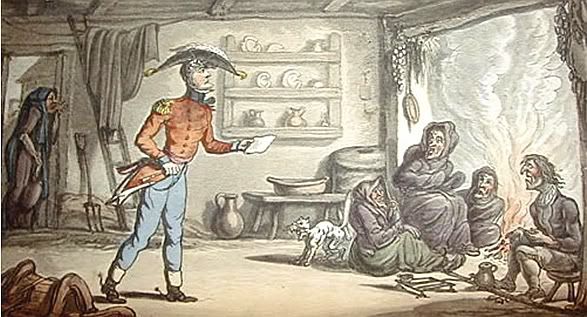
A peasant sitting on a cracket by a smoky fire. An engraving from The Military Adventures of Johnny Newcombe, illustrated by Thomas Rowlandson (1756-1827).
Cricket tables date from around the same period and were often made, like their lowly rustic counterparts, with the three turned (or shaved) legs being tennoned into a solid plank top. Early joyned examples were constructed in much the same manner as joyners made stools and other tables of the day i.e. they were assembled, often without glue, and their mortises and tennons were draw-pegged together.

A 17th century joyned oak cricket table, the circular top above a frieze drawer, on turned and block legs united by peripheral stretchers.

An extract from the painting A Country Inn Kitchen, by J.G. Mulvany (1766-1838), showing a simple turned cricket table.

A late eighteenth century cricket table with three-board top and shaped aprons.
We already have a turned Ash and Elm cracket in the living room, so I was drawn to a simple, late eighteenth style table with shaped aprons and straight legs with just a small amount of turned detail on the lower regions. The final design is not a copy of a particular table, but an amalgamation of strict elements borrowed from several tables which were made within the last twenty years of the eighteenth century. So in theory, it's possible there may be in existence, an antique table identical to the one I'm making.
Timbers commonly used for British vernacular furniture were Ash, Elm, fruitwoods (including Apple, Apricot, Cherry, Damson, Pear and Plum), Oak and Walnut. I happen to have some rather nice Ash at the moment and when I resawed it, I was pleasantly surprised to see areas of Olive Ash. The 'olive' occurrence is akin to spalting in Spalted Beech and the 'brown' in Brown Oak. It's caused by fungal attack and is purely a discolouration of the wood and not a structural defect. Any rural British joyner would have exploited the appearance of Olive Ash and, in keeping with the soul of the table, so shall I.
The most challenging part of the table is the cutting of the legs which are kite shaped with only two adjacent faces at right angles to each other. In my case, cutting the legs posed somewhat more of a problem than would normally be the case as I currently possess possibly the worst site saw ever manufactured. I bought it blind off the web from a woodworking machinery specialist. It's so flimsy and inaccurate; it's only good for breaking down sheet goods and roughly sawing slabs.
Elsewhere on the forum I posted a request for help with cutting the legs and Phil Spencer stepped forward, offering to cut the legs for me on his cabinet saw. Before turning the lower portion of the legs, I chopped out the mortices, using a specially made cradle to hold the mortice faces of the awkwardly shaped legs horizontal.
Before turning the lower portion of the legs, I chopped out the mortices, using a specially made cradle to hold the mortice faces of the awkwardly shaped legs horizontal.
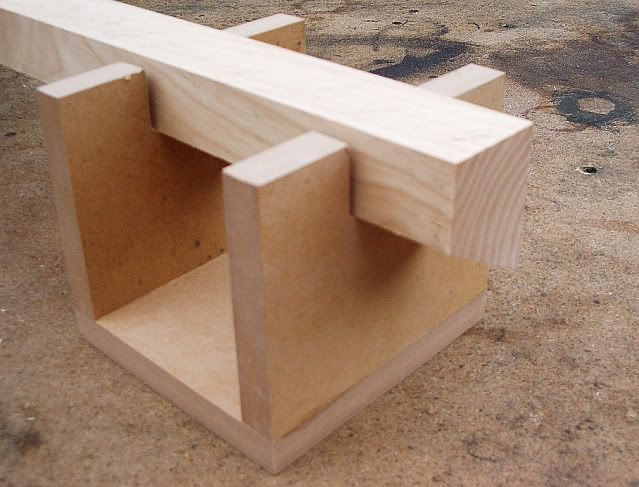
The leg cradle.
The ends of the aprons/rails are cut at an angle so as to splay the legs outwards at the bottom, thereby affording the table a wider stance and more stability. I drew the ogee profile onto the lower edges of the aprons, cut them out and tidied them up with a spokeshave. I drilled the holes in the legs for the draw pegs and then dry assembled the table frame. I marked the hole centres through the legs and onto the tennons, dismantled the frame again and drilled the off-centre holes in the tennons.
I installed the first apron into its respective legs and hammered in the pegs. Before proceeding with the remaining two aprons, I took the hammer and knocked the ends of the pegs off that were protruding from the inside of the legs. This may sound drastic and somewhat uncouth, but examination of the interior of early joyned furniture often reveals the broken ends of pegs where they might otherwise have impeded the installation of adjacent rails. With a triangular table, the next rails and leg are joined in unison and one just has to be precise with the lengths of the remaining pegs.
Cricket table tops were invariably made from three jointed boards (sometimes glued together). Occasionally one sees a single piece top (usually Elm due to its resistance to splitting), but they are customarily warped or cupped. Those thinking ahead will have realised that the three boards of the top will be well supported at one end (where they cross one of the rails at ninety degrees), however, at their opposite ends, only the centre board will be wholly supported and the ends of the two outside boards will be left tentatively detached from the frame. The solution is to let in a bearer, the same width as the base of the triangle and equidistant from the table centre as the base of the triangle.

The bearer in situ.
The bearer is a common feature of 'three-board' triangular tables and adds rigidity to the otherwise unsupported ends of the side boards³. Such bearers' ends were normally radiused and tapered, making them less obtrusive.
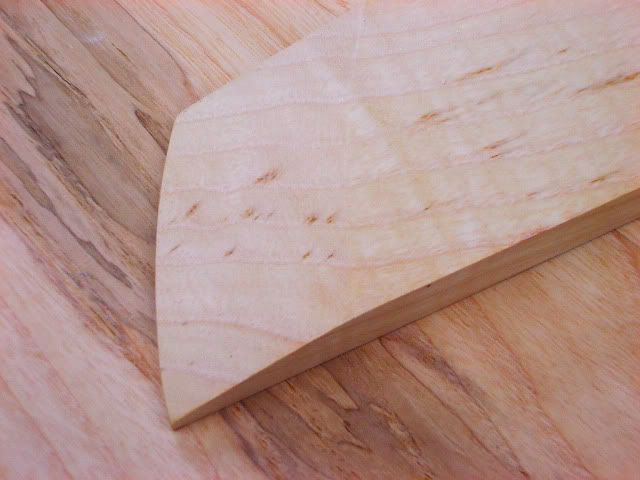
A radiused and tapered bearer end.
The bearer will be pegged to the rails before being nailed to the underside of the top with hand made nails.
1. English Country Furniture 1500-1900, David Knell, second edition, printed 2000, p. 255.
2. Irish Country Furniture 1700-1950, Claudia Kinmonth, printed 1993, p.30 with reference to Contributions to the Study of the Irish House: Smokehole and Chimney, A.T. Lucas.
3. Oak Furniture The British Tradition, Victor Chinnery, printed 1979, p. 296-297, plate 3:182b..
I know you believe you understand what you think I wrote, but I'm not sure you realize that what you just read is not what I meant.
Regards, Woodwould.
-
1st June 2009 07:43 PM # ADSGoogle Adsense Advertisement
- Join Date
- Always
- Location
- Advertising world
- Posts
- Many
-
1st June 2009, 07:51 PM #2

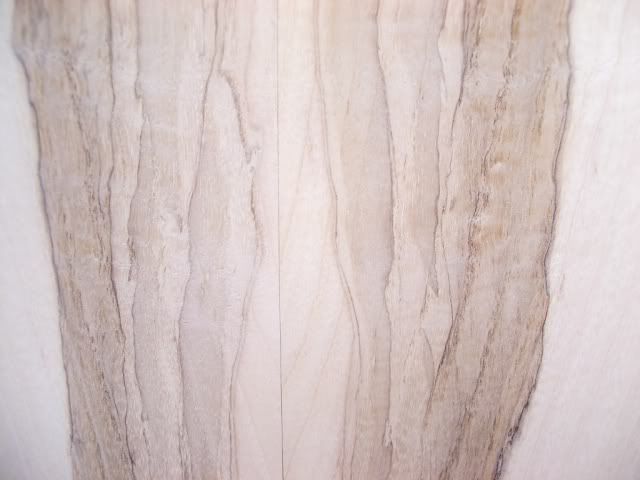
Olive Ash.

The frame assembled and pegged.
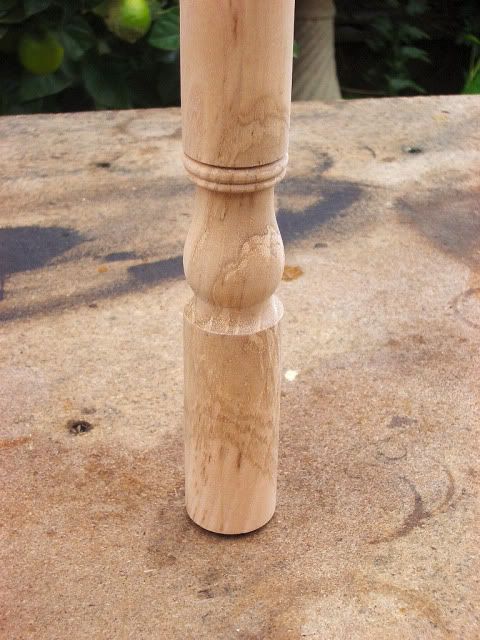
Leg detail showing some of the olive staining.
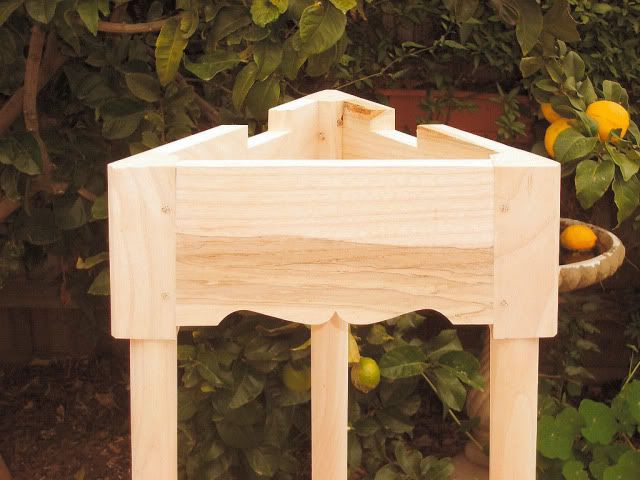
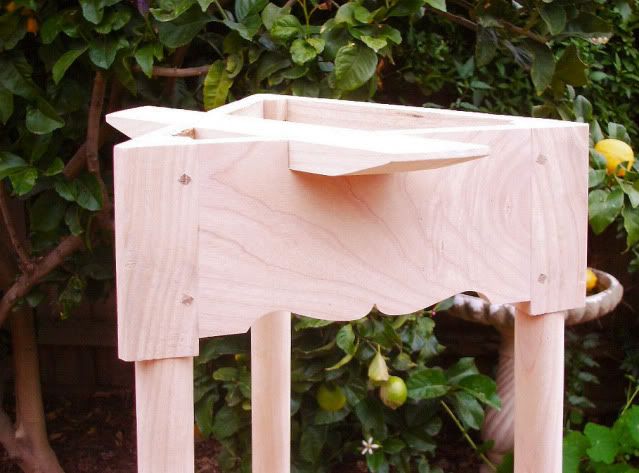
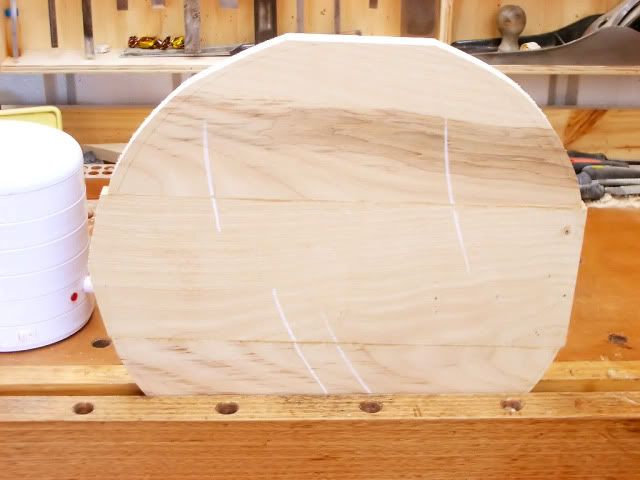
The three top boards rubbed together.
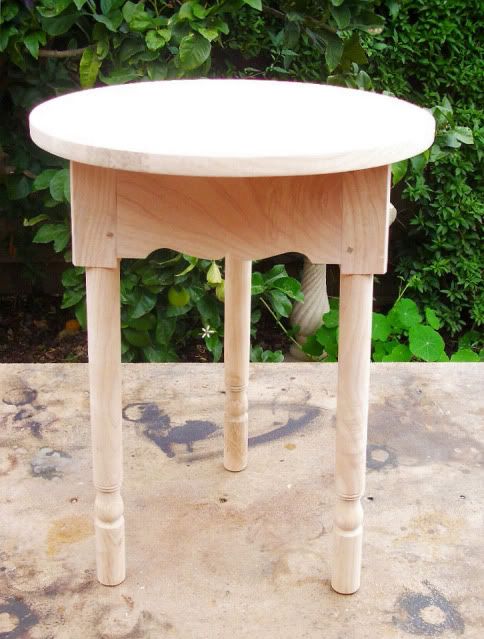
The top still to be pegged in place..
I know you believe you understand what you think I wrote, but I'm not sure you realize that what you just read is not what I meant.
Regards, Woodwould.
-
1st June 2009, 07:55 PM #3
 .
.











- Join Date
- Jul 2005
- Location
- Victoria
- Posts
- 5,215
-
1st June 2009, 07:56 PM #4

I'm always in awe of your work WW and a story nicely told. Keep 'em coming

Cheers
Michael
-
1st June 2009, 08:06 PM #5
 .
.
I know you believe you understand what you think I wrote, but I'm not sure you realize that what you just read is not what I meant.
Regards, Woodwould.
-
1st June 2009, 08:07 PM #6
-
1st June 2009, 08:19 PM #7
 Golden Member
Golden Member











- Join Date
- Oct 2006
- Location
- Dandenong Ranges
- Age
- 47
- Posts
- 816

Woo Hoo! Another WoodWould (re-)creation.
Wonderfully written and described. Always a pleasure to read and watch. ___________________________________________________________
___________________________________________________________
"The things I make may be for others, but how I make them is for me."
-
1st June 2009, 09:15 PM #8
 SENIOR MEMBER
SENIOR MEMBER











- Join Date
- Jul 2003
- Location
- Melbourne
- Age
- 53
- Posts
- 856

Awesome post Woodwould
 Looking forward to reading the rest of this thread.
Looking forward to reading the rest of this thread.
On the second post, second last pic the description of the top in the vice you said " The three top boards rubbed together."
Are you using hide glue and basically holding the joint together for a few seconds while the joint sets? One day i'd love to see some posts re the use of hide glue.
thanks
joez
-
1st June 2009, 09:26 PM #9

I always thoroughly enjoy your posts Woodwould.

I also like the way you've taken advantage of the spalted oak (or as I now correctly know it 'olive oak'). So is the term when correctly used dependant on the timber that has been affected, or is the wider term 'spalted' also correct?
-
1st June 2009, 10:31 PM #10
-
1st June 2009, 11:10 PM #11

The table has turned out very nice WW (infact dam nice), didn't take you long to get into it look forward to seeing it with the finish on.






regards
PhilTwo things are infinite: the universe and human stupidity; and I´m not so sure about the universe.
-
1st June 2009, 11:19 PM #12
 Senior Member
Senior Member











- Join Date
- May 2006
- Location
- Adelaide
- Age
- 71
- Posts
- 149

what a beauty!
loved the history attached too Woodwould.
regards
the block

-
2nd June 2009, 12:20 AM #13

lovely Crecket, and lovely story.

So is cricket called cricket cos there are three stumps?
Last edited by tea lady; 2nd June 2009 at 12:21 AM. Reason: 'nother thought.
anne-maria.
Tea Lady
(White with none)
Follow my little workshop/gallery on facebook. things of clay and wood.
-
2nd June 2009, 12:24 AM #14

Thanks Boy!

Thanks for the praise.
I stood the first board in the vice and applied thin animal glue to both mating surfaces and then litterally rubbed the second board back and forth until the glue began to gel and made sure I finished rubbing when the chalk marks lined up. Most of the glue gets squeezed out (the feint brown line visible in the picture). It's just a matter of repeating the process with the third board.
Once the three boards are rubbed together, I can actually pick the whole lot up by the top board and hold them horizontally without fear of the whole lot falling apart. It's very strong.
Fungal staining of timbers seems to have different names according to the timber in question. Stained Beech is known as Spalted Beech, stained Oak is Brown Oak and stained Ash is Olive Ash. I think spalting is also a generic term for fungal staining, as I've heard of other timbers being called 'spalted' such as Spalted Birch and Spalted Chestnut. I'm sure there are others.
Thanks to everyone for your kind words and support. I hope to get round to finishing the table later in the week..
I know you believe you understand what you think I wrote, but I'm not sure you realize that what you just read is not what I meant.
Regards, Woodwould.
-
2nd June 2009, 12:32 AM #15
 .
.
I know you believe you understand what you think I wrote, but I'm not sure you realize that what you just read is not what I meant.
Regards, Woodwould.
Similar Threads
-
An 18th century style Windsor chair.
By Woodwould in forum WOODWORK - GENERALReplies: 38Last Post: 7th March 2009, 04:55 PM -
18th century furniture pics
By Tex B in forum Links to: WEB SITESReplies: 0Last Post: 13th May 2007, 05:51 PM -
European Style pen tutorial
By Roll Tide in forum TUTORIALSReplies: 6Last Post: 14th March 2007, 05:13 AM -
Cricket, Indian Style
By Shedhand in forum NOTHING AT ALL TO DO WITH WOODWORKReplies: 2Last Post: 20th November 2006, 07:14 PM




 Reply With Quote
Reply With Quote


